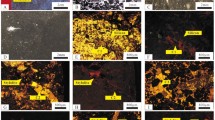Abstract
Cement minerals of Early Cretaceous sandstones and mudstones of the northen and southern Yamato ridges were investigated. Kaolinite, illite, chlorite, defective chlorite, mixed-layer illite-smectite, quartz, and plagioclase occur dominantly in the northern Yamato Ridge, whereas mixed-layer chlorite-saponite of trioctahedral mineral type (a corrensite-like mineral), dioctahedral mixed-layer illite-smectite, defective chlorite, illite, analcime, zeolites of heulandite group (gmelinite and clinoptilolite), laumontite, ankerite, barite, and epsomite occur in the southern Yamato Ridge. The cement minerals of Paleocene sandstones and mudstones are corrensite and corrensite-like minerals, mixed-layer illite-smectite, illite, defective chlorite, analcime, gmelinite, and barite. The Early Cretaceous rocks of the northern Yamato Ridge contain kaolinite, whereas those of the southern Yamato Ridge have corrensite, analcime, ankerite, barite, and epsomite. The presence of kaolinite suggests that there existed a land in the Early Cretaceous and climatic condition was probably damp and warm. The presence of corrensite, analcime, ankerite, barite, and epsomite is indicative of a sea or a salty lake and dry and hot climatic conditions. The same minerals are found in the Paleocene rocks of the southern Yamato Ridge, suggesting the presence of a sea or a salty lake and dry and hot climatic conditions. Physical properties such as porosity and density of the Early Cretaceous and paleocene rocks are identical, which suggests that both deposits were buried to a depth of 2–3 km where they were lithified. Considering the time interval of 25 million years between sedimentation of the Early Cretaceous and Paleocene rocks and sediment thickness up to 500–800 m, the southern Yamato Ridge was covered with a sea in both the Early Cretaceous and Paleocene time. Since the Neogene, a sea has developed on the area of southern Yamato Ridge. Occurrence of saline rocks on the Yamato Ridge suggests that they may extend to Korea, China, and Japan.
Similar content being viewed by others
References
Darragi, F. 1987, Authigenic trioctahedral smectites controlling pH, alkalinity, silica and magnesium concentration in alkaline lakes. Journal of Chemical Geology, 63, 59–72.
Dritz, V.A. and Sakharov, B.A., 1976, The X-ray Diffraction Analysis of Mixed-Layer Minerals. Geological Institute Press, Moscow, 256 p. (in Russian)
Hower, J., Eslinger, E.V., Hower, M.E. and Perry, E.A., 1976, Mechanism of burial metamorphism of argillaceous sediments. I. Mineralogical and chemical evidence. Geological Society of America Bulletin, 87, 92–931.
Kossovskaya, A.G. and Dritz, V.A., 1985, Genetic types of corrensite and corrensite-like minerals. Journal of Lithology and Useful Minerals, 5, 16–38. (in Russian)
Millot, G., 1968, Geology of Clays (Weathering, Sedimentology and Geochemistry). In: Kossovskaya, A.G. (ed.), Geologie des Argiles (Alternations, Sedimentologic and Geochimie), Nedra Press. Leningrad. 359 p. (in Russian)
Pettijohn, F., Potter, P. and Siever, R., 1976, Sands and Sandstones. World press, Moscow, 536 p. (in Russian)
Strakhov, N. M., 1960, Lithogenesis Theory (Vol. 1). Academy of Science USSR, Moscow, 212 p. (in Russian)
Strakhov, N. M., 1962a, Lithogenesis Theory (Vol. 2), Academy of Science USSR, Moscow, 537 p. (in Russian)
Strakhov, N. M., 1962b, Lithogenesis Theory (Vol. 3). Academy of Science USSR, Moscow, 549 p. (in Russian)
Terekhov, E.P. and Bragin, B.V., 1989, Early Cretaceous sandstones of a underwater rise of Yamato (Japanese sea). In: Konovalov, U.I. (ed.), New Data on Geology of Western Part of Pacific Ocean. Far Eastern Branch Russian Academy of Science, Vladivostok, p. 87–95. (in Russian)
Zherebthova, I.K. and Volkova, I.N., 1966, Experimental study of behavior of microelements during natural solar evaporation of water of the Black sea and brine of Sasik-Sivash lake. Journal of Geochemistry, 7, 832–1729. (in Russian)
Author information
Authors and Affiliations
Rights and permissions
About this article
Cite this article
Mozherovsky, A.V., Terekhov, E.P. Authigenic minerals in Early Cretaceous and Paleocene sedimentary rocks of the Yamato Ridge, East Sea. Geosci J 2, 148–159 (1998). https://doi.org/10.1007/BF02910258
Received:
Accepted:
Issue Date:
DOI: https://doi.org/10.1007/BF02910258




